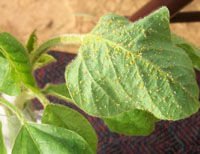Larger Soybean Aphid Populations A Potential in 2005
Larger Soybean Aphid Populations A Potential in 2005

Published on March 2, 2005
The soybean aphid has had relatively little impact on Kentucky fields since it was discovered in the United States four years ago. While 2005 also could be an uneventful year, some recent occurrences may have an impact on aphid populations.
“I think it is very likely that aphid populations in Kentucky will be larger than in past years,” said Doug Johnson, an Extension entomologist with the University of Kentucky College of Agriculture. “However, there are many weather and biocontrol-related factors that could change this.”
The biggest single difference in 2005 from other years is the likelihood that very large populations of soybean aphid may be available to start this season. For several years, David Voegtlin and his co-workers at the Illinois Natural History Survey have been working on methods of predicting aphid population size. It appears that the number of aphids, as caught in aphid traps, returning to colonize their primary host for over-wintering may be the best indicator.
This past fall very large numbers of aphid migrants were captured. So, based on previous years’ experience, larger populations are expected in 2005.
Nothing in the 2004 research changed his belief that the over-wintering host is not present or very rare in Kentucky, Johnson said. So, it is likely that aphids will still have to migrate in from northern states. This might change, however, if the aphid is able to adapt to other species.
Late-planted and/or late-maturing varieties of Kentucky soybeans are at greatest risk to aphids, he said.
Depending upon how widespread soybean rust is in Kentucky, treatment for this disease could have an impact on populations of soybean aphid and other soybean insect and mite pests. The fungicides that control soybean rust also will suppress the fungal diseases of insects. This could allow for larger soybean aphid populations as one of their natural controls is suppressed.
In addition, adding unneeded insecticides, applied at inappropriate times, will further suppress biological controls of soybean aphid and other insects. This will all become much more important if soybean rust treatment is widespread. If you must apply fungicides for soybean rust control, don't forget to look for insect resurgence later in the season, Johnson said.
A third factor is research results from the 2004 season have caused changes in threshold statements for 2005. The threshold number of aphids per plant remains at 250. However, the growth stage when this number should be used to make a decision has been altered.
In 2005, if you have 250 aphids per plant on average for a 30-plant sample per field, any time during the vegetative stages, through reproductive stage (beginning seed), then an insecticide application is appropriate. At full seed an economic return might be possible but is much less likely. After full seed, applications will not be economically appropriate. To keep up with changing information on soybean aphids in Kentucky, check theKentucky Integrated Pest Management Web page.
For more information on soybean pests and controls contact your county Extension Service office.
